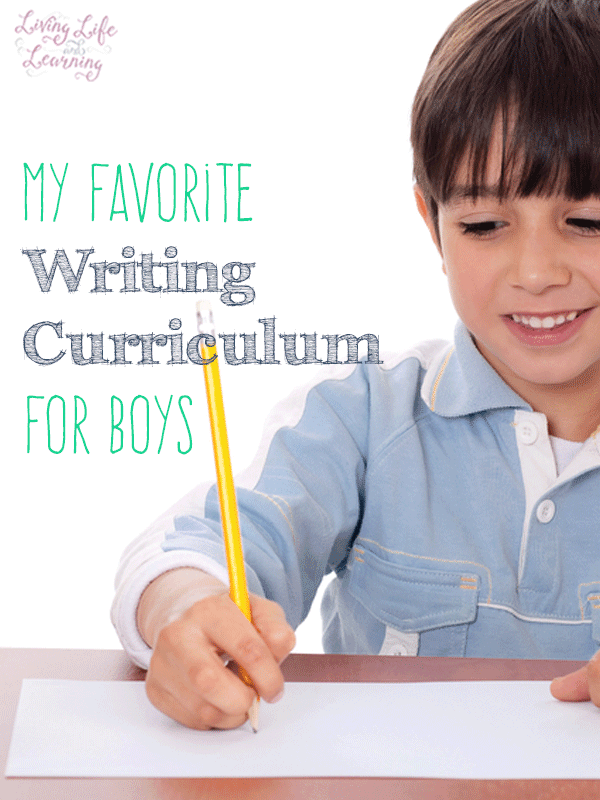My Favorite Writing Curriculum for Boys
I homeschool two boys and this is my list of favorite writing curriculum for boys. This is the first year that I am participating in The Virtual Curriculum Fair hosted at Homeschooling Hearts and Minds. This week is about Playing with Words.

© Depositphotos.com/get4net 
© Depositphotos.com/icefront 
© Depositphotos.com/realinemedia

This post may contain affiliate links meaning I get commissions for purchases made through links in this post. Read my disclosure policy here.
Homeschool Writing Curriculum for Boys
One of the first homeschooling books that I read and I still read it every year is The Well Trained Mind: Susan Wise Bauer, I love all the resources and suggested books and curriculum which is what I was in need of when I was just beginning. This lead me to Susan’s writing curriculum which I love The Complete Writing: Writing with Ease (WWE). This is exactly how I wanted to teach writing to my son. We had completed some other curriculum with random writing prompts and it just didn’t work for him because he’s a reluctant writer. When he is asked to write about what he would do if he was the Easter bunny, it just didn’t drive him to want to write about it. WWE uses copywork, dictation and narration from classic literature to teach your child to write. I love this concept. The book is geared towards grade 1-4 but you can obviously use it with older children, if they are struggling with these concepts. We started with narration by reading a paragraph at first, and then asking questions about it, or I’d ask what he remembered or what he thought was the most important. part. We then increased it to two paragraphs, then the and then to a couple pages, and then a chapter. Dictation teaches the child to hold words in their head, so that when the go to write, they don’t forget and lose their train of thought. You read the sentence aloud, 3 times if needed, and then your child writes it what he has heard. We started with short sentences and by the end of the book, M1 was up to 2 or 3 paragraphs. There are workbooks that accompany this text, if you don’t want to choose the passages yourself but I used their reading books or science/history books instead. So that he knew the material and he was already familiar and engaged with the stories to make writing about it easier for him. Another great book that I love and still reread is A Charlotte Mason Companion: Personal Reflections on The Gentle Art of Learning. I’m not a hardcore Charlotte Mason fan, since I didn’t go through the original 6 books about CM but I enjoyed this one since it summed up all her teachings. I think writing and narration go hand in hand. If your child does not understand what he is reading, how can he be asked to write about it? We would read a chapter from Paddle to the Sea: Holling C. Holling since each chapter was one page long and then either I would have him orally retell me what happened or write it out, depending on how much writing he was doing that day. I think you have to let the child get use to retelling things orally before you ask them to write about it. It’s a two step process which can be difficult especially if your child is still working on penmanship. I’ve also read Ruth Beechick’s The Three R’s and You Can Teach Your Child Successfully – Grades 4-8, which give great advice on how to teach writing on your own. As you can see I don’t like using specific curriculum in the early years other than WWE, which I use as a guide. M1 does a lot of writing across the curriculum with science and history, where his passions lie. This makes it so much easier for me to get quality writing out of him. So I’ll take our writing lesson and incorporate a science/history topic instead of using the suggested topic in the curriculum which can at times be boring. At the moment we are using Essentials in Writing with my 7th grader. I like that it incorporates grammar and writing together. I feel that since we’ve done writing in a more open way in the elementary years, that he needs a more guided approach now to learn about essays and such. Something that I don’t feel very comfortable teaching, I’m a math and science girl. Don’t forget to take a look at the other posts in this series:

- 3 Reasons to Read to Your Teens by Susan @ Homeschooling Hearts & Minds
- Language Arts {Virtual Curriculum Fair} by Chareen @ Every Bed of Roses
- A Classical Take on 6th Grade Language Arts by Christy @ Unexpected Homeschool
- The Power in a Word by Michele@ Family, Faith and Fridays
- The Latin Road to English Grammar Volume 1 by Kristi K. @ The Potter’s Hand Academy
- Starting a Foreign Language in Elementary School by Amy @ Eclectic Homeschooling
- These are the words we say by Christa @ Fairfield Corner Academy
- A Peek into our Homeschool: Language Arts by Brittney @ Mom’s Heart
- Our Curriculum Choices 2014 ~ English by Renata~Sunnyside Farm Fun
- Virtual Curriculum Fair: A World of Words by Joelle @ Homeschooling for His Glory
- It Starts with the Alphabet by Kristen @ Sunrise to Sunset
- Playing w/ Words-Charlotte Mason Style by Lynn P @ Ladybug Chronicles
- 2014 Virtual Curriculum Fair ~ Playing with Words: the Language Arts by Jennifer @ a glimpse of our life
- Our PreK-1st Grade Language Arts Mix by Tauna @ Proverbial Homemaker
- Fun (or Not) With Spelling by Nicole @ Schooling in the Sun
- Word Nerd Love by Lisa N@Golden Grasses
- Our Favourite Resources For Teaching Elementary Language Arts by Kim @ Homestead Acres
- Unconventional Reading Lessons While Homeschooling by Lori@My Journeys Through Life
- Virtual Curriculum Fair: Playing With Words – Language Arts by Stacie @Super Mommy To The Rescue
- Fun With the Language Arts by Mary @ Winecup Christian Homeschool
- Our Grammar Path by Laura @ Four Little Penguins
- Virtual Curriculum Fair !!! by Jessica @ Modest Mama
- Creating a High School English Course (or two) by Debra @Footprints in the Butter
- Language Arts in Our Homeschool This Year by Laura @ Day by Day in Our World


In my experience as a mom with four girls and one boy, it’s much harder to get my son to write creatively.
My daughter’s only two so I’m interested in seeing what learning style she has but she site is a tomboy now.
I love the Well-Trained Minds, too (my copy is well-worn) and try to incorporate a lot of the techniques suggested. Thank you for sharing how your pursue a classical language arts education for your kids!
Thanks Susan I need my own copy since I’m using the libraries. I take out at least 3 times a year
It’s awesome to see this approach working for you and so many others.